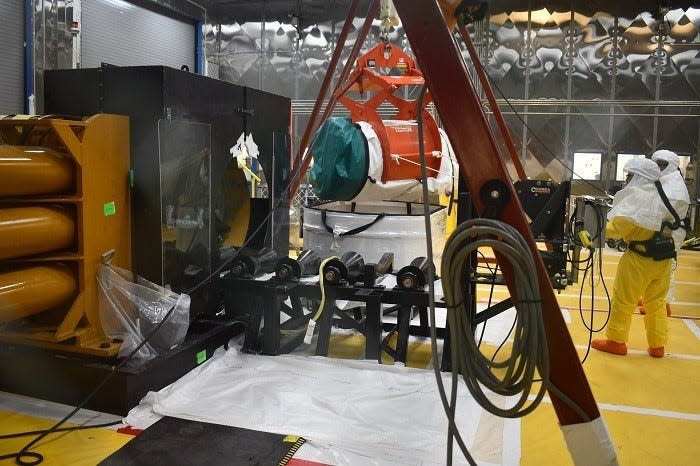Feds digging up nuclear waste in Los Alamos for disposal at Carlsbad-area repository
Workers at Los Alamos National Laboratory dug up buried nuclear waste they planned to dispose of at the federal repository near Carlsbad, amid pressure from State officials that the facility prioritize New Mexico waste.
The U.S. Department of Energy’s Los Alamos Field Office and the lab’s cleanup contractor Newport News Nuclear BWXT (N3B) Los Alamos announced Tuesday they began exhuming corrugated metal pipes containing transuranic (TRU) nuclear waste and preparing them for shipment.
At the Waste Isolation Pilot Plant near Carlsbad, TRU waste is disposed of via burial in a salt deposit about 2,000 feet underground, trucked into the site from DOE facilities throughout the country.
More: Holtec will lose millions in storing nuclear waste in New Mexico, whistleblower suit says
TRU waste is made up of irradiated clothing, equipment and other debris from nuclear research and development activities around the U.S.
Before it can be shipped to WIPP, the pipes must be cut using hydraulic sheers, allowing them to be loaded into waste boxes for shipment and disposal.
The pipes weight about 10,000 to 14,000 pounds, and measure about 20 feet long. They are cut into five pieces, with each piece loaded into a box.

More: Nuclear waste repository near Carlsbad staying open longer than estimated, officials say
It’s occurring at portion of the lab known as Dome 375, and the waste came from Los Alamos’ former radioactive liquid waste treatment facility operating during the Cold War at Technical Area 21 (TA-21).
There were 158 pipes in total transferred from TA-21, records show, containing cemented waste.
They were buried in 1986, where the waste sat until recently when worked began preparing it for final disposal.
The DOE hoped to finish digging up and preparing the pipes for disposal by spring 2024.
More: No progress to report on nuclear waste site aside from Carlsbad-area repository, feds say
N3B President Brad Smith said the work would help the DOE meet commitments to New Mexico to dispose of in-state waste.
“This is a significant milestone for N3B and will help us continue to drive down legacy waste inventories at LANL and to aid the DOE Office of Environmental Management in its meeting commitments to New Mexico,” he said.
New Mexico demands feds focus on state's nuclear waste
The pipe waste is one of several waste streams going from Los Alamos to WIPP.
DOE records show 1,615 TRU waste shipments were made to WIPP from the lab since the repository opened in 1999.
More: Shaft to fix air constraints at nuclear waste repository near Carlsbad reaches final depth
Los Alamos had the third-most shipments of the DOE’s active facilities, following 1,721 from the Savannah River Site in South Carolina and 6,957 shipments from Idaho National Laboratory.
Another 10 shipments were reported from Sandia National Laboratories in Albuquerque, meaning about 12 percent of WIPP’s shipments were from within New Mexico, compared with about 51 percent from Idaho alone.
Recently, amid negotiations on WIPP’s 10-year permit renewal, the New Mexico Environment Department added language to the permit requiring the DOE to prioritize waste from within New Mexico, chiefly from Los Alamos.
More: Air system at nuclear waste repository near Carlsbad makes progress as site nears capacity
The DOE and NMED reached a settlement on the permit language for the next decade of WIPP operations and planned a public hearing on the changes this fall.
The Los Alamos priority was in response to the State’s concern for agreements between the DOE with other states like Idaho, that saw more waste coming from out of state to the WIPP repository that from within New Mexico.
Critics said this meant New Mexico took on the burden and risk posed by the waste, without its own facilities benefitting from the disposal.
More: Nuclear waste terms agreed on by New Mexico and feds for WIPP facility near Carlsbad
As initially proposed, the permit renewal added language requiring more waste shipped to WIPP from Los Alamos than any other DOE facility, but the wording was altered to remove any ratio requirement.
“Instead, it requires prioritization of legacy waste, which is important. That’s the waste that is in the environment and is the biggest problem,” said Don Hancock at the Southwest Research and Information Center. “There’s a new focus on legacy waste at the generator sites.”
Hancock said the DOE must focus on “legacy waste” generated during the Cold War and presently sitting in the environment, rather than waste resulting from nuclear weapons production as the DOE planned to ramp up plutonium pit development at Los Alamos and the Savannah River Site.
“There’s going to be a new public process to define what is legacy waste. That is important because WIPP always was supposed to be for Cold War waste, not new production or new pits,” Hancock said of the new permit requirements. “We’re not totally there in my opinion, but for the first time we’re moving toward that.”
Adrian Hedden can be reached at 575-628-5516, achedden@currentargus.com or @AdrianHedden on Twitter.
This article originally appeared on Carlsbad Current-Argus: Feds digging up nuclear waste in Los Alamos for disposal at Carlsbad-area repository

